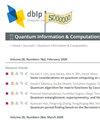cones嵌入问题
IF 0.7
4区 物理与天体物理
Q3 COMPUTER SCIENCE, THEORY & METHODS
引用次数: 2
摘要
我们证明了在双结果同步相关集的情况下,Connes的嵌入问题等价于弱Tsirelson问题。进一步证明了双结果同步相关集的极值点可以用一类泛C*-代数来实现。我们在三个实验的情况下检验这些代数,并验证强和弱Tsirelson问题在这种情况下有肯定的答案。本文章由计算机程序翻译,如有差异,请以英文原文为准。
The Connes embedding problem
We show that Connes’ embedding problem is equivalent to the weak Tsirelson problem in the setting of two-outcome synchronous correlation sets. We further show that the extreme points of two-outcome synchronous correlation sets can be realized using a certain class of universal C*-algebras. We examine these algebras in the three-experiment case and verify that the strong and weak Tsirelson problems have affirmative answers in that setting.
求助全文
通过发布文献求助,成功后即可免费获取论文全文。
去求助
来源期刊

Quantum Information & Computation
物理-计算机:理论方法
CiteScore
1.70
自引率
0.00%
发文量
42
审稿时长
3.3 months
期刊介绍:
Quantum Information & Computation provides a forum for distribution of information in all areas of quantum information processing. Original articles, survey articles, reviews, tutorials, perspectives, and correspondences are all welcome. Computer science, physics and mathematics are covered. Both theory and experiments are included. Illustrative subjects include quantum algorithms, quantum information theory, quantum complexity theory, quantum cryptology, quantum communication and measurements, proposals and experiments on the implementation of quantum computation, communications, and entanglement in all areas of science including ion traps, cavity QED, photons, nuclear magnetic resonance, and solid-state proposals.
 求助内容:
求助内容: 应助结果提醒方式:
应助结果提醒方式:


